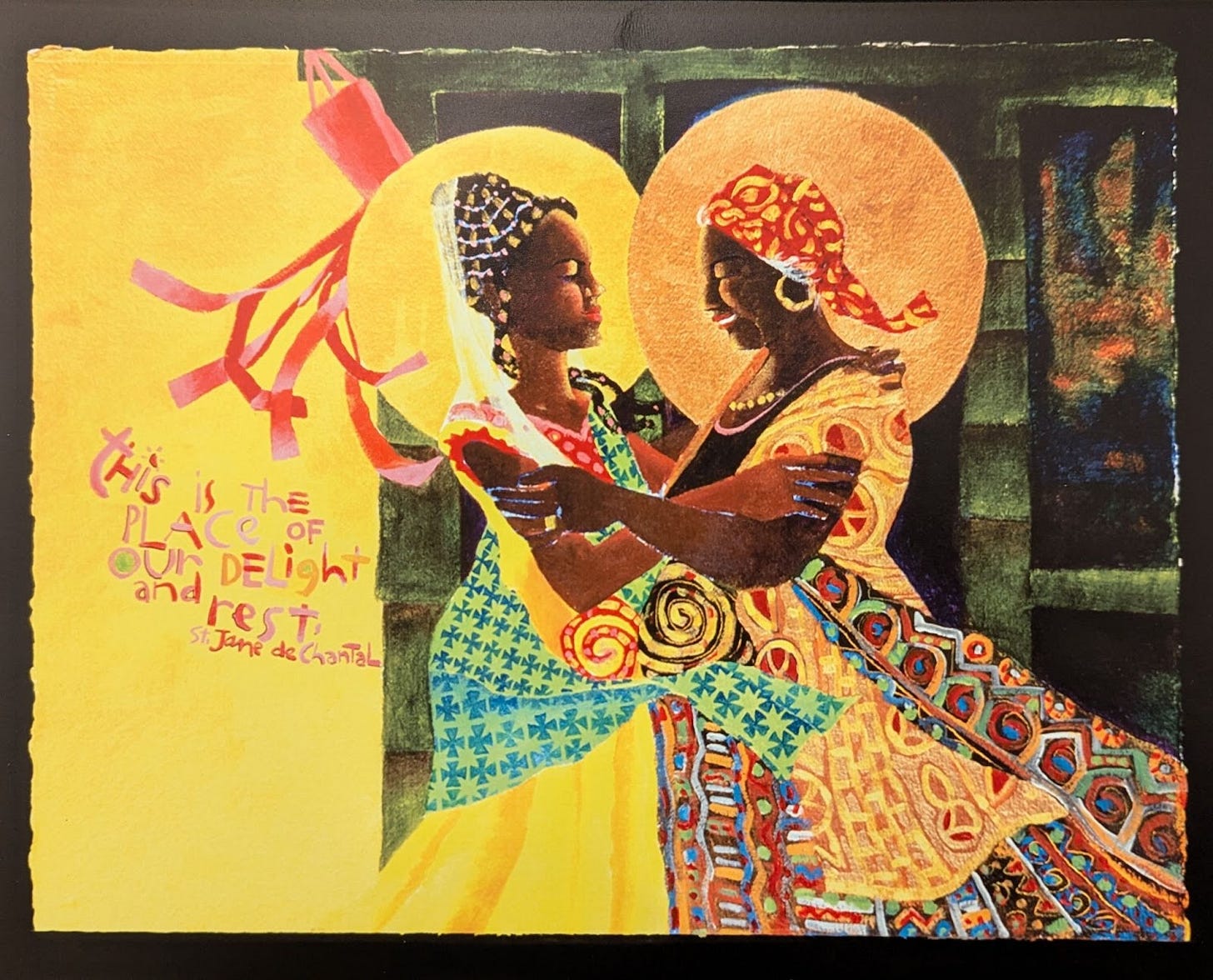In an earlier post (that you can read here), I described how when we have larger expectations for scripture, we realize that the Bible is a giant library of holy testimony. That collection of diverse testimony points toward a much larger trajectory than many of us were taught—God With Us. This God wants to live among humans, and this is a narrative of progressive presence—every time humans wreck the story, God gets closer and the story gets wider.
So yes, as many will mention this time of year, Jesus is “Emmanuel,” but it’s so much more than a prophecy; God With Us is the story we are in.
But to release the smaller expectations of smaller stories, we often have to be willing to be surprised.
In many churches, the third week of Advent focuses on joy and often focuses on Mary. But joy can be tricky, especially this time of year when many of us are also remembering grief and loss—joy is not the same thing as happiness or pleasant circumstances. I have heard joy defined as “metabolized pain,” I’ve also heard joy described as “bright sorrow,” and a couple years ago I came up with my own definition: joy is imagination in the ruins.
All throughout scripture, joy is a connection to trusting God for delight and deliverance right in the middle of hard circumstances, and Mary points the way for us.
In Luke chapter 1, Mary receives an unexpected announcement that she will give birth to a child who will be the Son of the Most High. She soon goes to visit her relative Elizabeth (who is also surprisingly pregnant), and when Elizabeth and the baby in her womb rejoice at hearing Mary’s voice, she sings:
My soul magnifies the Lord, and my spirit rejoices in God my Savior, for he has looked with favor on the lowly state of his servant. Surely from now on all generations will call me blessed, for the Mighty One has done great things for me, and holy is his name; indeed, his mercy is for those who fear him from generation to generation. He has shown strength with his arm; he has scattered the proud in the imagination of their hearts. He has brought down the powerful from their thrones and lifted up the lowly; he has filled the hungry with good things and sent the rich away empty. He has come to the aid of his child Israel, in remembrance of his mercy, according to the promise he made to our ancestors, to Abraham and to his descendants forever.
Surprise after surprise pile up in the first couple chapters of Luke. Now Mary knows—God has come near.
Jesus is the Word from the mouth of God, spoken into the world. In the middle of John chapter 1 we read that the Word became flesh and lived among us—this is “God With Us.” The Greek verb translated “dwelled” or “lived among” means to tabernacle or to pitch a tent—the Word became human flesh and tabernacled among humans. In Eugene Peterson’s paraphrase, The Message, he phrases it “the Word became flesh and blood and moved into the neighborhood.”
Why?
Because that’s what this God is like. Jesus shows us what God is like. This is revelation — Jesus reveals what God is like. Instead of privilege and power and distance, this God chooses vulnerability and proximity—Advent means arrival. We are waiting and longing and groaning—along with the whole world for God to show up.
But the way God shows up is a total surprise.
And it seems like it’s a little hard for God to keep a secret :) God announces the surprise to a handful of people ahead of time, sending messengers ahead of time to Joseph, to Zechariah, and to Mary.
Can you imagine? I don’t think we should picture warm fuzzy Hallmark angels bringing these world-shifting announcements—all three of them are told “Don’t be afraid!” But Mary models for us a consent to the surprising work of God’s Spirit.
I grew up in a church (that I love) that didn’t celebrate Advent, and we didn’t talk about Mary much either. And so as an adult I found myself so thirsty for both—for this season of longing to shape who I am, and to reflect more on the character of Mary—who she was and what she experienced.
So of course I was fascinated to learn that ancient Greek theologians in their imaginations had seen a connection between Mary and Moses at the burning bush. In a chapter on Moses, Ellen Davis explains how:
Mary who carried God in her belly and did not dissolve to ash—she is herself the bush that burns perpetually, yet is not consumed… Mary and Moses have this in common: in the history of the world, they are the two people who have known God most intimately, known God in ways that human flesh ordinarily could not tolerate without burning to a cinder… These are the two more-or-less ordinary people in the history of the world with whom it seems, God has felt most fully at home. Moses and Mary are the ones who made the most room in their lives and therefore in the world for God’s dramatically new work of deliverance. Knowingly and willingly, they welcomed God as God is, utterly demanding and utterly loving… [they both model for us] this capacity to be derailed for the sake of the things of God.1
I want to learn to make that much room for God in my life. I want to be willing to have the surprises of God disrupt the plans I thought I had for my life—because revelation will always be larger.
Artist Scott Erickson writes about Mary:
All great stories come at a cost, and the cost of revelation is that it’s going to ask something of us…. But the rub of revelation is that it’s a transformation you’re not in charge of… Revelation is a hard gift to receive. You must give up everything else to receive it—like finding a treasure in a field and selling everything you have so you can get that treasure. But then again, she who is willing to accept the cost of revelation finds herself in the deepest of stories.2
And it makes me ask myself: am I looking for surprise? Where am I looking for surprise? This God chooses to reveal the surprise first to a poor young woman, her poor fiance, a couple of their elderly relatives, some animals, some shepherds, and foreign astrologers. These are not the movers or shakers in their world - not the influencers. They were viewed as unimportant by those at the center of “important society,” yet God trusted them with the secret first.
A couple years ago I heard a preacher say that if we’re really trusting God, we should never be surprised—we can maybe have awe, but not surprise—and that preacher said that on the first Sunday of Advent. I was so dismayed. Instead, Advent teaches us that it is maybe those who are having to trust God the most who learn to look for God to surprise them the most.
Because she was willing for God’s surprise to interrupt her life, Mary delivers the Word of God to the whole world.
I think my mistake sometimes is to think that the surprising work of God ended with incarnation or crucifixion or resurrection or Pentecost. But God’s joy is a surprise that continues to find us right in the middle of the brokenness of the world.
We are invited to be surprised by God.
Mary made room for God to surprise her, and she birthed the body of Christ.
We also labor to birth the Body of Christ in this world. May we each trust God for delight and deliverance even in the middle of struggle. May we learn to look for God’s surprise and to make room for God like Mary.
© Ladye Rachel Howell. All Rights Reserved.
See Getting Involved With God: Rediscovering the God of the Old Testament by Ellen Davis.
See Honest Advent: Awakening to the Wonder of God-With-Us Then, Here, and Now by Scott Erickson.










